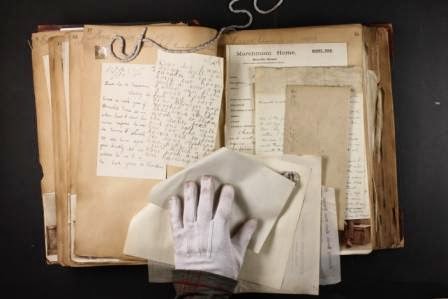On letters -
“This is just me, me the way I write, the way my writing is, the way I want to be to you, giving myself to you across a distance, not keeping or retaining any part of it for myself, giving this piece of myself totally, and you can tear me up or throw me out, or keep me, and read me today, tomorrow, any time you want until you die.”
 |
| Emigration scrap books |
We have hundreds of letters in our collection, some of which we’ve shown you
before. They cover sea journeys, Christmas, Easter, life on a farm, school and friendships. Most of all however they suggest the presence of an individual who lived and worked in days long ago. To the reader they can bring up all kinds of emotions. The penmanship whether beautiful or scrawled, ink indented into paper, tells a story in itself. If read by an academic the content can bring life to history, filling in gaps, bringing a social context to facts and figures. To the family historian the emotion is quite different. Here is a letter written by an ancestor. To touch that item is to create a link between two far away generations. The letter is priceless; no monetary value can be placed on it.
 |
Extract from an emigration letter c. 1920s
|
Most of the letters contained in our scrap books were written in the first few years after emigration. Fewer give details when they were in adulthood. The letter above however, was written after the First World War by a Canadian home child who had returned briefly to England. He had been emigrated in 1912 at the age of 17. Many of these later letters often ask for advice or guidance from the charity as well as telling news to their old ‘mothers’ in the homes. To the ancestors of this child it may give a personal account of parents, grandparents or great grandparents meetings. They may even reveal a skeleton in the cupboard as this letter does in later lines.
I’m not going to tell you what it is though. That’s for their ancestors to find out….



Comments
Post a Comment
Like to know more about a certain home or period in the Together Trust's history? Why not comment and let us know.
If you have a personal or more specific enquiry please see our 'Contact Us' section at the top of this page to get in touch via email.